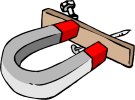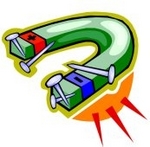By Trista L. Pollard

|
Fields of Attraction and Poles
By Trista L. Pollard |

|
 1 The fields are alive with the spark of attraction! We have all heard the saying "opposites attract," but how far away can they be before they attract? The answer lies in magnetic fields of force. A magnetic field of force is the invisible area around a magnet where the force of the magnet can be felt. This field of force allows the magnet to attract steel and iron objects without touching them. This invisible field can be inferred based upon how steel and iron objects react to the magnet from a distance. For example, if you place a paper clip on a table near a magnet, the paper clip will be drawn into the field of force, therefore moving towards the magnet. Attraction from a distance has occurred.
1 The fields are alive with the spark of attraction! We have all heard the saying "opposites attract," but how far away can they be before they attract? The answer lies in magnetic fields of force. A magnetic field of force is the invisible area around a magnet where the force of the magnet can be felt. This field of force allows the magnet to attract steel and iron objects without touching them. This invisible field can be inferred based upon how steel and iron objects react to the magnet from a distance. For example, if you place a paper clip on a table near a magnet, the paper clip will be drawn into the field of force, therefore moving towards the magnet. Attraction from a distance has occurred. |
Create Weekly Reading Books
Prepare for an entire week at once! |
| Leave your feedback on Fields of Attraction and Poles (grades 5-7) (use this link if you found an error in the story) |
 |
Electricity Worksheets | edHelper.com
|
 |
Magnets and Magnetism Worksheets | edHelper.com
|
 |
Science
|